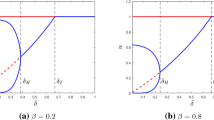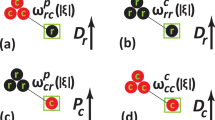Abstract
Simple predator-prey models often predict extreme instability in interactions where the prey are depressed well below their carrying capacity. Although the behaviour of some laboratory systems conforms to this pattern, field and mesocosm studies generally show prolonged co-existence of prey and predator. Prominent among the possible causes of this discrepancy are the effects of spatial heterogeneity. In this paper we show that both discrete and continuous representations of the spatial Rosenzweig-McArthur model with immobile prey can be stabilized by self-organized prey heterogeneity. This concordance of behaviour closely parallels that which we have previously established in the context of invasion waves. We use the continuous model variant to calculate the characteristic spatial scales of the self-organized structures. The discrete variant forms the basis of a simulation study demonstrating the variety of stable structures and elucidating their relation to the history of the system. We note that all stable prey distributions take the form of a network of occupied patches separated by prey-free regions, and liken the process which generates such assemblages to the formation of a landscape mozaic.
Similar content being viewed by others
References
De Roos, A. M., E. McCauley and W. G. Wilson (1998). Pattern formation and the spatial scale of interactions between predators and their prey. Theor. Pop. Biol. 53, 108–130.
Gause, G. F. (1934). The Struggle for Existence, New York: Hafner.
Gilpin, M. E. (1972). Enriched predator-prey systems: theoretical stability. Science 177, 902–904.
Gurney, W. S. C. and R. M. Nisbet (1975). The regulation of inhomogeneous populations. J. Theor. Biol. 52, 441–457.
Gurney, W. S. C. and R. M. Nisbet (1976). Spatial pattern and the mechanism of population regulation. J. Theor. Biol. 59, 361–370.
Gurney, W. S. C. and R. M. Nisbet (1998). Ecological Dynamics, New York: Oxford University Press, pp. 162–163.
Gurney, W. S. C., A. R. Veitch, I. Cruickshank and G. McGeachin (1998). Circles and spirals: population persistence in a spatially explicit predator-prey model. Ecology 79, 2516–2530.
Huffaker, C. B. (1958). Experimental studies on predation: dispersion factors and predator-prey oscillations. Hilgardia 27, 343–383.
Jansen, V. A. A. (1994). Theoretical aspects of metapopulation dynamics, PhD thesis, University of Leiden, Netherlands.
Jansen, V. A. A. (1995). Regulation of predator-prey systems through spatial interactions: a possible solution to the paradox of enrichment. Oikos 74, 384–390.
Jansen, V. A. A. and A. M. de Roos (1998). Predator-prey dynamics across spatial scales: the role of space in reducing population cycles, in The Geometry of Ecological Interactions: Simplifying Spatial Complexity, O. Diekmann, R. Law and A. J. Metz (Eds), Cambridge: Cambridge University Press.
McCauley, E. and W. W. Murdoch (1987). Cyclic and stable populations—plankton as a paradigm. Am. Naturalist 129, 97–121.
McCauley, E. and W. W. Murdoch (1990). Predator-prey dynamics in environments rich and poor in nutrients. Nature 343, 455–457.
McCauley, E., W. G. Wilson and A. M. de Roos (1996). Dynamics of age structured predator-prey populations in space: asymmetrical effects of mobility in juvenile and adult predators. Oikos 76, 485–497.
McLaughlin, J. F. and J. Roughgarden (1991). Pattern & stability in predator-prey communities: how diffusion in spatially variable environments affects the Lotka-Volterra model. Theor. Pop. Biol. 40, 148–172.
McLaughlin, J. F. and J. Roughgarden (1992). Predation across spatial scales in heterogeneous environments. Theor. Pop. Biol. 41, 277–299.
Murdoch, W. W., R. M. Nisbet, E. McCauley, A. M. de Roos and W. S. C. Gurney (1998). Plankton abundance and dynamics across nutrient levels: tests of hypotheses. Ecology 79, 1339–1356.
Rosenzweig, M. L. (1971). The paradox of enrichment: the destabilisation of exploitation ecosystems in ecological time. Science 171, 385–387.
Author information
Authors and Affiliations
Rights and permissions
About this article
Cite this article
Gurney, W.S.C., Veitch, A.R. Self-organization, scale and stability in a spatial predator-prey interaction. Bull. Math. Biol. 62, 61–86 (2000). https://doi.org/10.1006/bulm.1999.0130
Received:
Accepted:
Issue Date:
DOI: https://doi.org/10.1006/bulm.1999.0130




